Why Were Chainsaws Invented?
Unless you’ve been living under a rock for the past century, I’m sure you know what a chainsaw looks like. And you would also know that it’s a pretty efficient tool at the hands of a logger who wants to cut down a large tree, right? And even homeowners find it useful for occasional property maintenance these days.
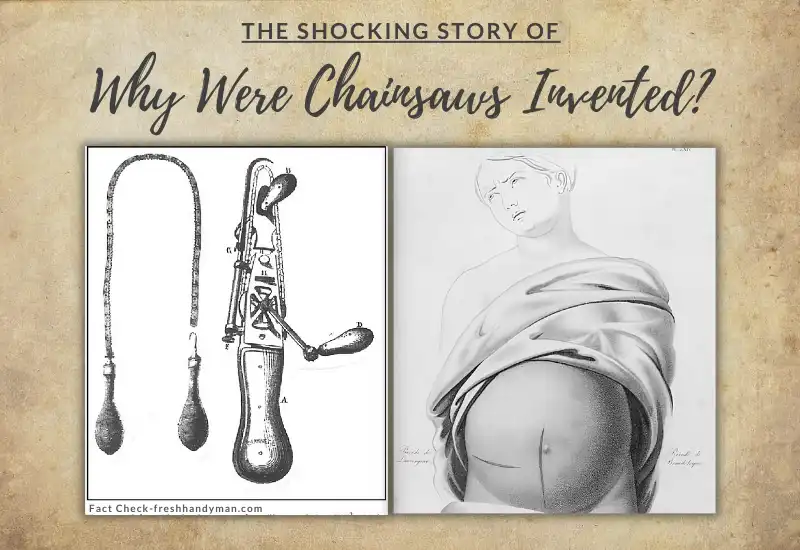
But what if I told you that forestry and property maintenance was not the primary purpose of the first chainsaw?
As odd as it sounds, chainsaws were invented for an entirely different reason entirely – and that reason is to aid in childbirth. Now I’m sure you are wondering – how on earth does a chainsaw help in childbirth?
Well, in difficult childbirths, doctors use a chainsaw to remove the pelvic bone of the mother to help the baby pass through the birth canal easier.
It was a risky operation and would often result in the death of the mother. Thankfully, those days are behind us, and using chainsaws during labor is no longer a thing.
Frankly, the story is pretty fascinating, albeit a bit horrific. With that said, brace yourself for a lesser-known history of the chainsaw, one that has been overshadowed for a considerable time.
What Were Chainsaws Made For?
They say necessity is the mother of invention, and the conception of the chainsaw came out of a simple necessity. But to understand that, you need to travel to the past long before the invention of local anesthetic or modern medicinal practices.
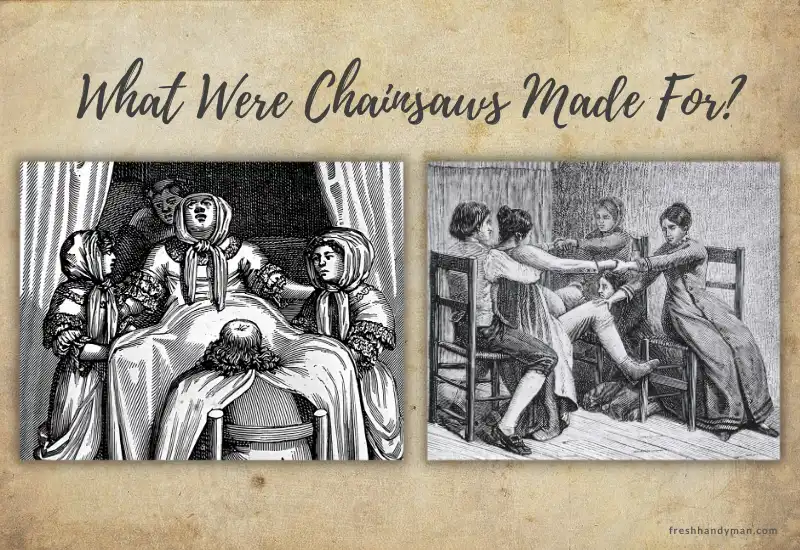
You see, childbirth has always been a challenge throughout history. And even though things are much better now with a mortality rate of 211 per 100,000, back in the 17th century, the number was much, much higher.
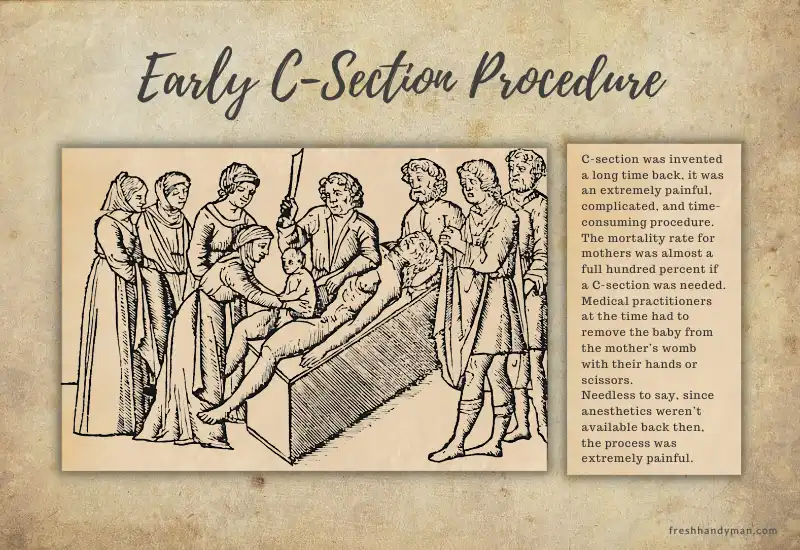
While C-section was invented a long time back, it was an extremely painful, complicated, and time-consuming procedure. The mortality rate for mothers was almost a full hundred percent if a C-section was needed. Medical practitioners at the time had to remove the baby from the mother’s womb with their hands or scissors.
Needless to say, since anesthetics weren’t available back then, the process was extremely painful. And the fact that cutting through the womb with a knife or scissors isn’t exactly fast also didn’t help.
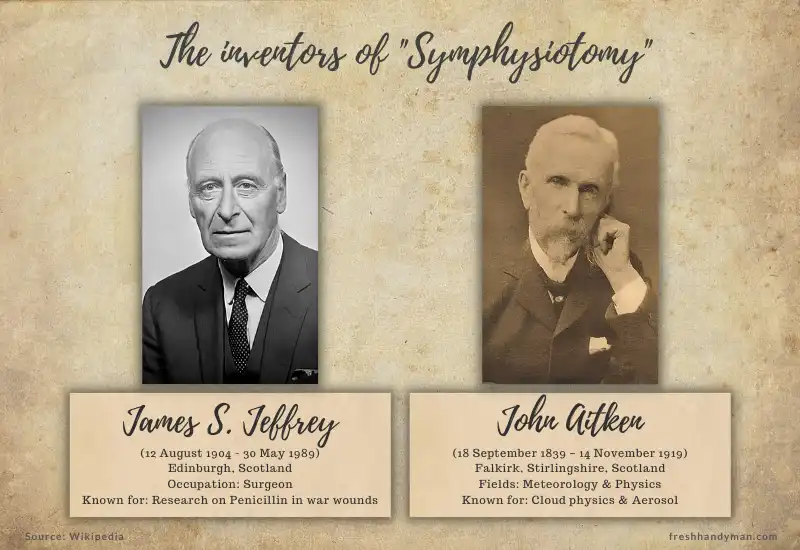
Later on, around 1780, two Scottish doctors, John Aitken and James Jeffery, came up with a safer, or rather faster, alternative to C-section.
They decided to cut into the mother’s pelvic bone instead of cutting into the abdomen to open up the birth canal and remove the baby vaginally.
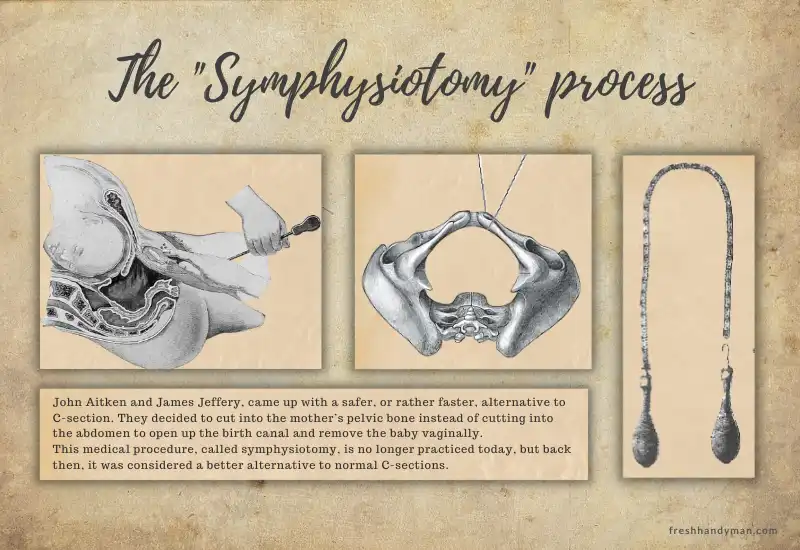
This medical procedure, called symphysiotomy, is no longer practiced today, but back then, it was considered a better alternative to normal C-sections.
However, using a knife or scissors for this process was not very practical since they wouldn’t be able to cut through the pelvic bone.
So, they devised a machine with a rotating blade that could quickly cut through the bone and cartilage.
But instead of using a chain, they used serrated rotating blades in this iteration of the chainsaw. And while it made the process faster, it was still quite dangerous for the mother.
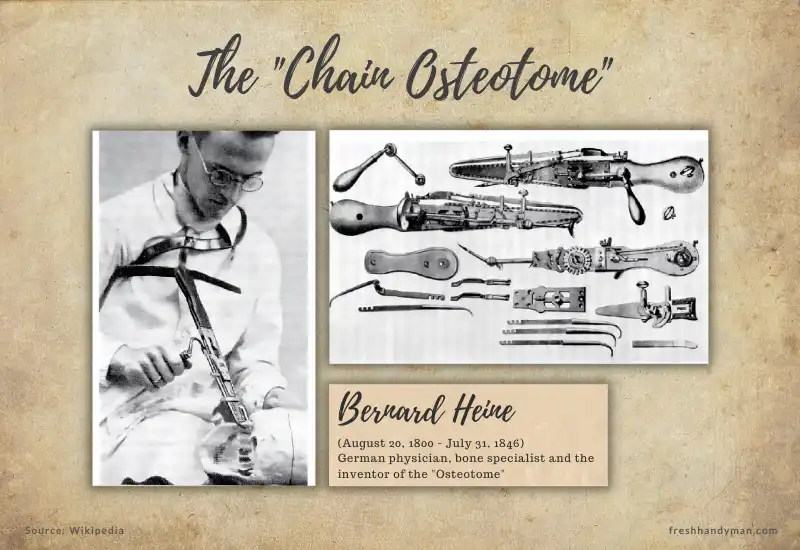
About 50 years later, a German orthopedic surgeon named Bernard Heine improved upon the design and invented the chain osteotome, which is considered the direct ancestor of modern chainsaws available now.
The chain osteotome, as the name suggests, used a rotating chain instead of a serrated knife and was used regularly for medical practices for a long time after its invention.
What Did the First Chainsaw Look Like?
The medical osteotome that Bernard Heine designed looked nothing like the chainsaw that we use these days. It was operated manually by a hand crank. The crank was attached to the side of the device, and the operator had to rotate it around a guiding blade.
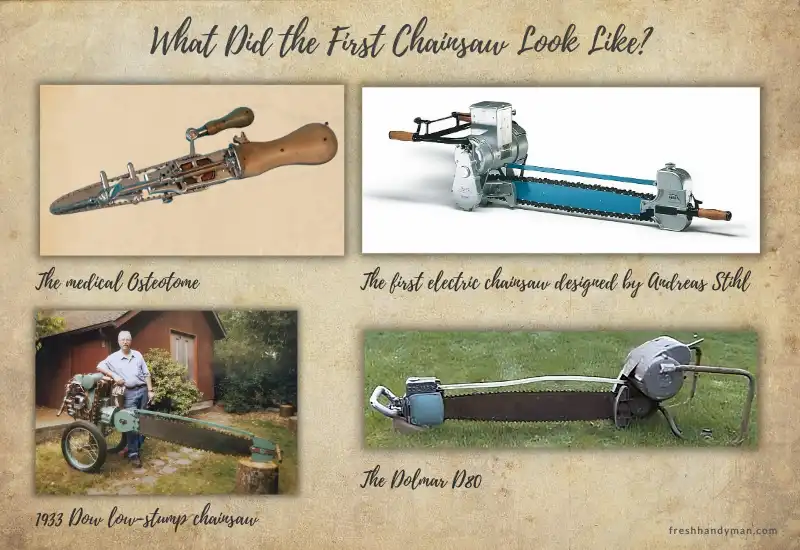
And even when you look at the early rendition of chainsaws that were designed for wood cutting and tree felling, you wouldn’t find anything that looks close to the chainsaws of today.
Those were massive machines and weighed hundreds of pounds. And those chainsaws were operated using a crane.
The electric chainsaw that Andreas Stihl designed later on was somewhat similar to modern chainsaws.
In fact, that was the time when chainsaws were starting to become popular among woodworkers. These chainsaws required two or more people to operate and still weighed quite a bit.
As for the first one-person operated chainsaw, it was designed by the brand Dolmar called the Dolmar D80. But though it’s a one-person chainsaw, it was still quite heavy, which means using it was pretty awkward and uncomfortable for the operator.
Who Invented the Chainsaw?
The earliest example of a device that resembles anything close to a chainsaw can be dated as far back as 1780. As mentioned earlier, two Scottish doctors,
John Aitken, and James Jeffrey,
They are responsible for the first chainsaw-like device in the world.
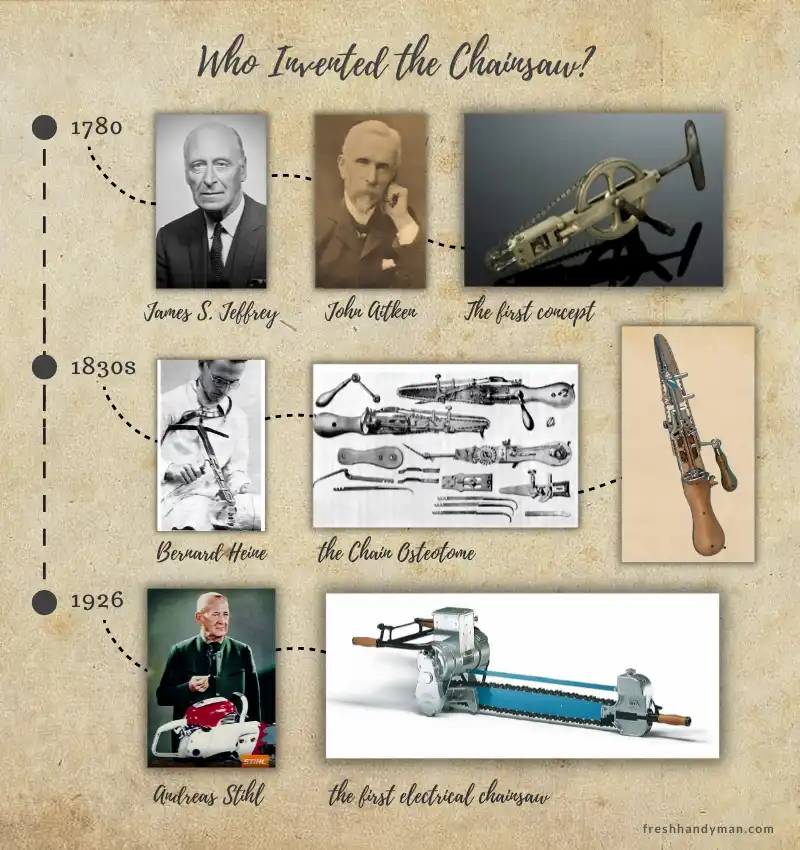
Dr. Jeffrey specialized in anatomy and botany and worked at Glasgow University for around 58 years. He talked in detail about the invention of the chainsaw in 1806 in his published Cases of the Excision of Carious Joints.
And for a long while, his invention was used in surgery until the arrival of Gigli’s twisted-wire saw. Since Gigli saw was easier and cheaper to manufacture, surgeons decided to make the switch.
In the 1830s, Bernard Heine developed a chainsaw-like device called chain osteotome that quickly superseded both the older design and Gigli wire saws. In 1883, a patent was passed for a chainsaw for cutting wooden boards as well.
However, the first chainsaw with the primary intent of felling trees came much later, around the 1890s, and John Muir is responsible for this feat.
The only downside to this new device is that it required a crane to operate and weighed hundreds of pounds. Naturally, it didn’t have a massive commercial appeal.
In 1926 the German mechanic Andreas Stihl (Yes – THAT Stihl) patented the first electrical chainsaw.
He quickly followed it up with a gasoline-powered chainsaw only three years later. But those chainsaws required at least two people to operate them.
But the honor of manufacturing the first one-person chainsaw goes to the brand Dolmar because of their infamous D80.
As you can see, crediting a single individual for the chainsaw that we know today would be quite unfair.
All the people that I mentioned above had a role to play in the improvement of its design. It was the collective vision of a group of people in different time periods that led to the modern chainsaw that we know today.
VIDEO– The Real Reason: Why Were Chainsaws Invented
Frequently Asked Questions
Now that you have a clearer grip on why a chainsaw was invented, my job is almost done. But I also understand if you still have some questions about it. So let me give you a quick refresher with a couple of key questions that I have seen people ask about the history of a chainsaw.
When Was the Chainsaw Invented?
The first chainsaw that was designed for medical purposes came out in the 1780s. John Aitken and James Jeffery, two Scottish medical practitioners, were responsible for the first medical chainsaw.
However, the first chainsaw for wood-cutting purposes wouldn’t come out until much later, on January 17, 1905, when Samuel J. Benz of San Francisco designed a device that was capable of felling giant redwoods.
The portable chainsaws that we see today are somewhat recent. Back then, chainsaws were large and required a lot of manpower and effort to use safely. Over time, the design became more efficient. The first one-man chainsaw was designed by Dolmar in 1950.
When Did They Stop Using Chainsaws for Childbirth
The use of chainsaws for childbirth, however barbaric it may seem to today’s standards, was in practice for a long time. As for the exact date when symphysiotomy was left behind, that detail is unknown. There are conflicting accounts that can make things a bit confusing.
In fact, there are rumors that it is still practiced in remote locations in the world where medical care and technology is still not as advanced as the other parts. In the Republic of Ireland, an estimated 1500 women went through this procedure without consent between the years 1944 and 1987.
In 2002, Matilda Behan, a survivor of this medical procedure, set up an advocacy group with her daughter Bernadette, for the victims of this practice. The agency is called Survivors of Symphysiotomy, or SoS for short.
What Was the Chainsaw Originally Called?
The medical chainsaw was called the osteotome. This is a combination of two Greek words, Osteo meaning bone, and Tome, or Tomi, which means bone. Basically, the medical chainsaw was a bone-cutting tool.
It was invented for a dangerous medical procedure called symphysiotomy, where the doctors would have to cut through the pelvic bone of the mother to widen the birth canal if there were any complications during labor.
Needless to say, this procedure was extremely dangerous and would often leave the mother suffering from long-term health problems if they managed to survive the ordeal.
Are Chainsaws Still Used for Childbirth?
While chainsaws are still used for medical purposes such as limb amputation, it’s no longer even an option to aid in childbirth. What you need to understand is that the medical technologies available today were unimaginable in the 1800s. And while it might sound barbaric today, the medical osteotome actually did save the life of the baby should the worst come to pass.
These days, cesarean is the go-to procedure to aid in childbirth if there are any complications. The use of chainsaws in medical practices is strictly limited to limb amputation in case of an accident or disease.
Parting Wisdom
The history of chainsaws might be gruesome and cringe-worthy, but you cannot deny how useful it is today. It took a long time for chainsaws to get where they are now. And none of it would be possible if two Scottish doctors didn’t take the initiative to make a device that could make childbirth easier.
It just goes to show you how one thing can quickly lead to another. When Dr. Aitken and Jeffrey were theorizing their version of the chainsaw, I’m pretty sure they couldn’t imagine the avalanche of events that they would set in motion. And once Andreas Stihl took the reins, chainsaws would never be the same again.
I hope this discussion on the history of chainsaws could help you appreciate the amazing wood-cutting machines that we have today. Cheers!